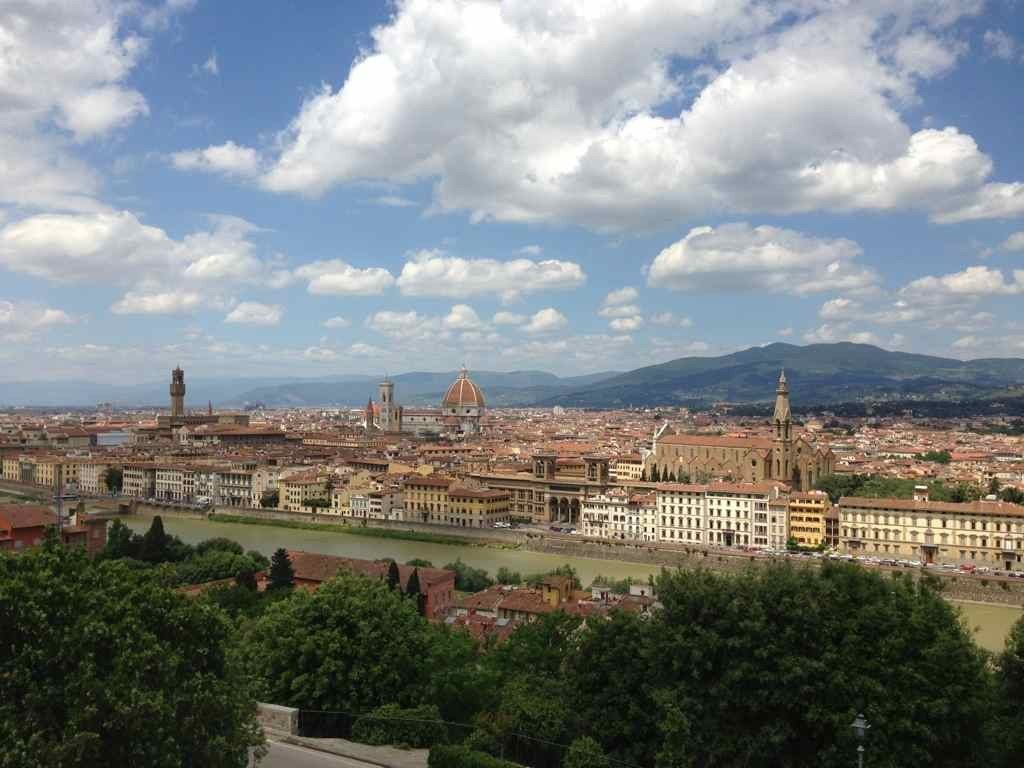Week 1
Week 1: Monday, October 7, 2024
Manuel Chrysoloras Comes to Florence
Week 1
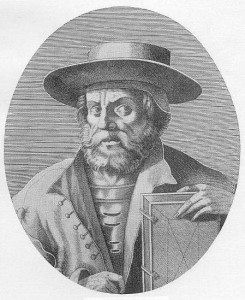
In 1390, Manuel Chrysoloras (1355-1415) came to Venice on a diplomatic errand as the representative of the Byzantine Emperor in Constantinople. While visiting Venice he met a number of Florentines and one, Giacomo da Scarperia, followed him home to Constantinople to study Greek. Other Florentines heard about Chrysoloras and therefore in 1396, the Florentine Chancellor Coluccio Salutati invited Chrysoloras to come to Florence as a professor of Greek. Chrysoloras would teach the ancient language to whomever might want to attend the classes. This event—a formal program of Europeans studying Greek—is as useful a mark for the beginning of the Renaissance as any. With the arrival of Chrysoloras in Florence, almost a thousand years of Western European ignorance of Greek came to an end. And with this new field of study came new books, new publications, new ideas. The study of Greek sparked new interest in mathematics, astronomy, geography, geometry, optics, and cartography. By the 1420’s Florence found itself the center of an international movement that would create modern Europe.
REQUIRED READING: This week, Chapter IV, "Florence"
Our text for this Fall Quarter is the very fine introduction to the Renaissance by one of our greatest historians, J. R. Plumb. This inexpensive volume will serve us well for all ten weeks of the Fall Quarter. Please read the beautiful obituary that appeared in 2001, when Professor Plumb died, and you will be able to better appreciate his achievements.

J. H. Plumb,
The Italian Renaissance,
Mariner Books; Revised edition (June 19, 2001),
ISBN 0618127380
Amazon: Spanning an age that witnessed great achievements in the arts and sciences, this definitive overview of the Italian Renaissance will both captivate ordinary readers and challenge specialists. Dr. Plumb’s impressive and provocative narrative is accompanied by contributions from leading historians, including Morris Bishop, J. Bronowski, Maria Bellonci, and many more, who have further illuminated the lives of some of the era’s most unforgettable personalities, from Petrarch to Pope Pius II, Michelangelo to Isabella d'Este, Machiavelli to Leonardo. A highly readable and engaging volume, THE ITALIAN RENAISSANCE is a perfect introduction to the movement that shaped the Western world.
RECOMMENDED READING:
J. R. Hale, The Civilization of Europe in the Renaissance. This study of the whole Renaissance period in all of Europe was the final masterpiece of one of the greatest historians of the Early Modern period. John Hale was working on this book when he suffered a debilitating stroke. But his wife, Sheila Hale, and other scholars finished the book for publication and we are all enriched by its availability. It is in print, but you might also look at used copies of the original quality paperback. This book will serve us for the whole year-long course. It is especially useful for Winter and Spring Quarters.

John Hale,
The Civilization of Europe in the Renaissance,
Scribner, Reprint edition (June 1, 1995),
ISBN 0684803526
Ferdinand Schevill, Medieval and Renaissance Florence. The Schevill book that we used in on our class during "The History of Medieval Italy," is still useful for this Renaissance class. But this year you would only want Volume 2 on Renaissance Florence. It is a very detailed historical record of events in Florence during the Fifteenth Century. If you want one book to give you the year by year events and explanations of basic political structures, this is the book you want to own. Copies of both volumes are in our Institute library.
This two-volume history of Florence is the best detailed study of Florence ever written. Schevill wrote a masterpiece of well researched narrative history for Florence in 1936 and then it was republished in a Harper Torchbook paperback in 1961. The Harper Torchbook is still out there in used book stores so we have purchased five for our library. But there are still copies left if you want to own one. It is two volumes with the first volume devoted to our period of Medieval History and the second volume on Renaissance Florence. For the Lombards see Medieval Florence (Volume 1) Chapter Three, "Darkness Over Florence."

Ferdinand Schevill,
Medieval and Renaissance Florence,
Harper Torchbook paperback, 1963, 2 volumes,
ISBN B000PX4SUU
2
Week 2: Monday, October 14, 2024
Ptolemy Comes to Florence
Week 2
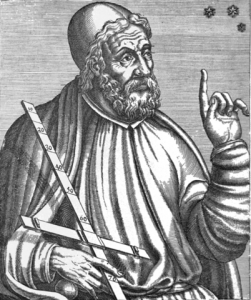
Claudius Ptolemy was a Greek mathematician living in Alexandria from about 90 AD to 168 AD. He was living in the international Roman Empire within which Egypt was now just another province. His Greek language heritage connected him to the whole Greek scientific tradition. He had access to everything back to Thales, including Aristotle, Plato, Euclid— everything. In the great metropolis of Alexandria with the greatest library in the world, Ptolemy brought together in his book, Geography, all knowledge of the globe that Greek science had gathered. He is the first writer to explain completely the idea of latitude and longitude. He provided latitude and longitude locations for all the major cities of Europe. He also provided in his book a how-to guide on drawing maps of the three dimensional globe on two dimensional flat paper. Ptolemy's book was brought to Florence in 1400, probably by Manuel Chrysoloras, and the new arrival of this book in Europe sparked the whole Fifteenth Century research in cartography and led directly to the journey of Christopher Columbus to North America.
REQUIRED READING:

J. H. Plumb,
The Italian Renaissance,
Mariner Books; Revised edition (June 19, 2001),
ISBN 0618127380
RECOMMENDED READING:
1. J. R. Hale, The Civilization of Europe in the Renaissance. This study of the whole Renaissance period in all of Europe was the final masterpiece of one of the greatest historians of the Early Modern period. John Hale was working on this book when he was struck with a debilitating stroke. But his wife, Sheila Hale, and other scholars finished the book for publication and we are all enriched by its availability. It is in print, but you might also look at used copies of the original quality paperback. This book will serve us for the whole year-long course. It is especially useful for Winter and Spring Quarters.

John Hale,
The Civilization of Europe in the Renaissance,
Scribner, Reprint edition (June 1, 1995),
ISBN 0684803526
2. Ferdinand Schevill, Medieval and Renaissance Florence. The Schevill book that we used in on our class during "The History of Medieval Italy," is still useful for this Renaissance class. But this year you would only want Volume 2 on Renaissance Florence. It is a very detailed historical record of events in Florence during the Fifteenth Century. If you want one book to give you the year by year events and explanations of basic political structures, this is the book you want to own. Copies of both volumes are in our Institute library.

Ferdinand Schevill,
Medieval and Renaissance Florence,
Harper Torchbook paperback, 1963, 2 volumes,
ISBN B000PX4SUU
3
Week 3: Monday, October 21, 2024
Vitruvius Comes to Florence
Marcus Vitruvius Pollio (80 BC to 15 BC) was a Roman architect, engineer and author. His greatest work was his book On Architecture. Below you see a 17th Century engraving of Vitruvius presenting his book on architecture to Emperor Augustus. De architectura is a treatise on architecture written by the Roman architect Vitruvius and dedicated to his patron, the emperor Caesar Augustus, as a guide for building projects. Vitruvius' book is our only surviving work on Roman art. It includes not only architecture but comments on other visual arts as well. Probably written around 15 BC, it is the only contemporary source on classical architecture to have survived, except for the loss of all original illustrations. Divided into ten sections or "books", it covers almost every aspect of Roman architecture. The books break down as:
De architectura – Ten Books on Architecture
- Town planning, architecture or civil engineering in general, and the qualifications required of an architect or more modernly the civil engineer
- Building materials
- Temples and the orders of architecture
- 'continuation of book IV'
- Civil buildings
- Domestic buildings
- Pavements and decorative plasterwork
- Water supplies and aqueducts
- Sciences influencing architecture – geometry, measurement, astronomy, sundial
- Use and construction of machines - Roman siege engines, water mills, drainage machines, Roman technology, hoisting, pneumatics
Vitruvius' book was rediscovered in a Swiss monastery of the Abbey of Saint Gallen by Florentine scholar Poggio Bracciolini, and a copy of the book was brought to Florence in 1414. Brunelleschi used Vitruvius to develop his new idea of linear perspective.
REQUIRED READING:

J. H. Plumb,
The Italian Renaissance,
Mariner Books; Revised edition (June 19, 2001),
ISBN 0618127380
RECOMMENDED READING:

John Hale,
The Civilization of Europe in the Renaissance,
Scribner, Reprint edition (June 1, 1995),
ISBN 0684803526
RECOMMENDED READING:
This is a wonderful book that is perfect for us as we spend a week talking about Brunelleschi and Renaissance Florence. I highly recommend it to you all. And now it is available in paperback.
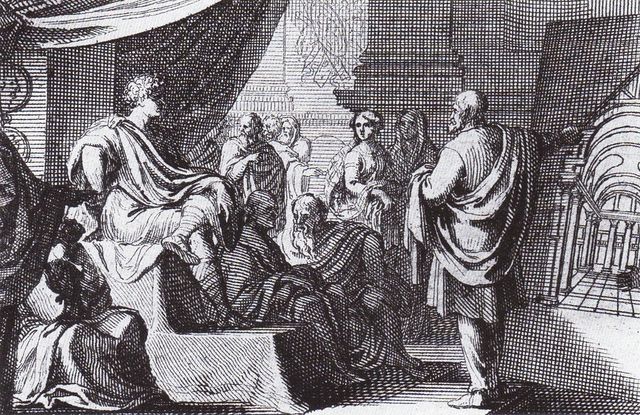
4
Week 4: Monday, October 28, 2024
Why Florence?
Week 4
Why did Florence turn out to be so special in 1400? For the answer we must go back into the medieval history of Florence and trace the growth of democratic institutions in the growing republic. The republic of Florence grew out of the debris of the dying Roman Empire. As the empire collapsed, local citizens had to organize in an attempt to provide services and establish some local order. All over Italy, in the 500 years from the last of imperial control in Italy (c. 564) to the birth of new Italy in 1000 AD, local officials reacted to the chaos of the imperial collapse. In each small state, experiments were begun in order to create local civic structures. By the late 1200's (during the lifetime of Dante) Florence had created a vibrant genuinely democratic regime dominated by the commercial middle class. This democracy learned how to support industry, export-import, labor, and a banking system. Even the catastrophe of the Black Death in 1348 could not stop the success of the Florentine Republic. By 1400, Florence was more successful than ever.
REQUIRED READING:

J. H. Plumb,
The Italian Renaissance,
Mariner Books; Revised edition (June 19, 2001),
ISBN 0618127380
Amazon: Spanning an age that witnessed great achievements in the arts and sciences, this definitive overview of the Italian Renaissance will both captivate ordinary readers and challenge specialists. Dr. Plumb’s impressive and provocative narrative is accompanied by contributions from leading historians, including Morris Bishop, J. Bronowski, Maria Bellonci, and many more, who have further illuminated the lives of some of the era’s most unforgettable personalities, from Petrarch to Pope Pius II, Michelangelo to Isabella d'Este, Machiavelli to Leonardo. A highly readable and engaging volume, THE ITALIAN RENAISSANCE is a perfect introduction to the movement that shaped the Western world.
RECOMMENDED READING:
J. R. Hale, The Civilization of Europe in the Renaissance. This study of the whole Renaissance period in all of Europe was the final masterpiece of one of the greatest historians of the Early Modern period. John Hale was working on this book when he suffered a debilitating stroke. But his wife, Sheila Hale, and other scholars finished the book for publication and we are all enriched by its availability. It is in print, but you might also look at used copies of the original quality paperback. This book will serve us for the whole year-long course. It is especially useful for Winter and Spring Quarters.

John Hale,
The Civilization of Europe in the Renaissance,
Scribner, Reprint edition (June 1, 1995),
ISBN 0684803526
5
Week 5: Monday, November 4, 2024
Money, Banks and the Florin
Week 5
How did Florence get so rich by 1400? During week 5 we want to explore the generation of wealth. How does it happen? What are the factors that promote the wealth of a people? And what did Florence do between 1200 and 1400 that turned out to be the right things. What were some of these creations: 1) a sound money; 2) a banking system; 3) government support for property rights.
REQUIRED READING:

J. H. Plumb,
The Italian Renaissance,
Mariner Books; Revised edition (June 19, 2001),
ISBN 0618127380
RECOMMENDED READING:
The Raymond de Roover study of the Medici bank is a masterpiece of economic history.

Raymond de Roover,
The Rise and Decline of the Medici Bank: 1397-1494,
Beard Books (August 19, 1999),
ISBN 1893122328
Review
The book combines superb research and analysis with graceful writing...(work) from archival material, make (this) valuable... -- Turnarounds and Workouts, October 15, 1999 Review by Susan Pannell
From the Publisher
A classic history of banking and trade in the medieval period, combining superb research and analysis with graceful writing. The Medici Bank was the most powerful banking house of the 15th century. Headquartered in Florence, Italy, it established branches in Rome, Venice, Geneva, Lyons, Bruges, London, and many other cities. The bank served as financial agent of the Church, extended credit to monarchs, and facilitated international trade in Western Europe. By their personal influence and the use of their profits, the owners and administrators of the bank contributed significantly to the development of Florence as the greatest center of the Renaissance.

John Hale,
The Civilization of Europe in the Renaissance,
Scribner, Reprint edition (June 1, 1995),
ISBN 0684803526
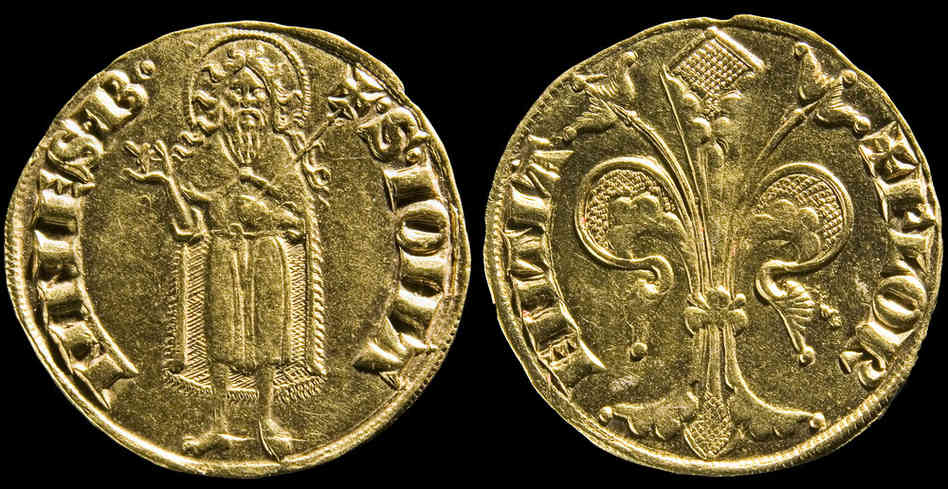
6
Week 6: Monday, November 11, 2024
The Catasto in Florence
Week 6
Who was rich and who was not in Renaissance Florence. The Catasto tells us. The Catasto was a innovation in taxation. In 1427, facing huge military costs as the little republic fought the big ric h state of Milan, the leaders of Florence decided that everyone should contribute to the cost of running the Republic. And I an attempt to make taxation more fair, they passed a law that established the Catasto. In the imposition of the new tax system, all Florentine citizens were asked to file a written assessment of all their wealth
With the Republic's Tax office. Then with this document on file, the Republic now asked all citizens to pay 1% (the amount varied over the different years of the existence of the Catasto) tax on their total wealth. Of course tax investigators could go door to door and check on the self-assessment. But the most important thing for us in the 21st century is that all these documents still exist in the Archivio di Stato Firenze. And scholars have been able to summarize the overall wealth, wealth distribution and everything else about money in Florence in 1327. In this our week 7 we will report some of their findings.
RECOMMENDED READING:
This is one of the greatest achievements of recent historical scholarship. Herlihy and Klapisch-Zuber studied the whole of the Catasto and with the results they were able to describe in fascinating detail the daily life in Florence in the early years of the fifteenth century.
The kindle edition is a reasonable price. And there are both new and used copies of the paperback.

Christiane Klapisch-Zuber and David Herlihy,
Tuscans and Their Families: A Study of the Florentine Catasto of 1427,
ACLS Humanities E-Book (August 1, 2008),
ISBN 1597405159

John Hale,
The Civilization of Europe in the Renaissance,
Scribner, Reprint edition (June 1, 1995),
ISBN 0684803526
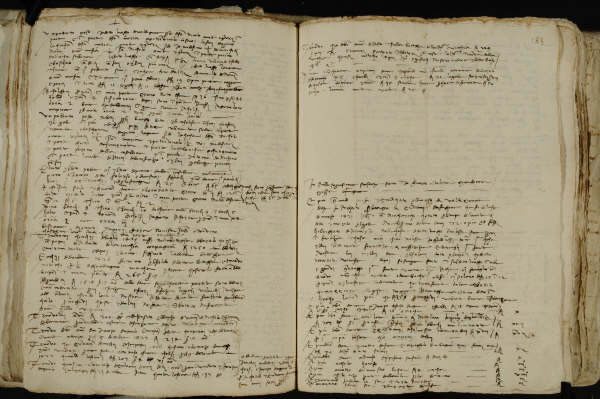
7
Week 7: Monday, November 18, 2024
The Families of Florence
Week 7
Italian society has always been dominated by families. Renaissance Florence was no exception. There were about 100 great families that led the Florentine Republic in the 300 years between 1200 and 1500. But for the great period of the Renaissance Florence (1400-1500) three families had extraordinary power: the Medici, the Strozzi, and the Rucellai.
Our reading for this week is one of the most valuable documents to come down to us from Renaissance Florence. This collection of letters written by Alessandra degli Strozzi to her children living outside of Florence, provides us with an insight into what life was like for the upper class Strozzi family in a world dominated by the Medici. Get your own copy so that you can appreciate her wit and charm.
REQUIRED READING:

Heather Gregory,
The Selected Letters of Alessandra degli Strozzi,
University of California Press, Bilingual ed edition (February 1, 1997),
ISBN 0520203909
The Institute's Outline of Letters
RECOMMENDED READING:
J. R. Hale, The Civilization of Europe in the Renaissance. This study of the whole Renaissance period in all of Europe was the final masterpiece of one of the greatest historians of the Early Modern period. John Hale was working on this book when he suffered a debilitating stroke. But his wife, Sheila Hale, and other scholars finished the book for publication and we are all enriched by its availability. It is in print, but you might also look at used copies of the original quality paperback. This book will serve us for the whole year-long course. It is especially useful for Winter and Spring Quarters.

John Hale,
The Civilization of Europe in the Renaissance,
Scribner, Reprint edition (June 1, 1995),
ISBN 0684803526
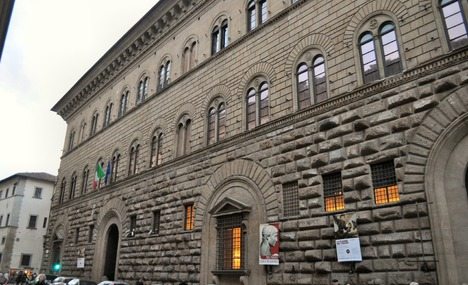
NO CLASS NEXT WEEK THANKSGIVING VACATION ALL WEEK
8
Week 8: Monday, December 2, 2024
Florence and the Popes
Week 8
The wealth of Florence meant that Florentines would be immensely influential as the Papacy began to rebuild the institution after the disasters of the Fourteenth Century. The Avignon Papacy had alienated England. The Schism with three popes had alienated almost everybody and then finally the Council of Constance in 1415 had tried to find a candidate to rebuild the church. They chose a Roman, Martin of the great Colonna family. But Martin spent many years living in Florence and Pope Eugenius IV (seen below consecrating the Florentine monastery of San Marco) lived in Florence in the cloister of Santa Maria Novella for a decade. Both popes solicited funds from the Medici and others in their efforts to rebuild both the city and the church of Rome.
REQUIRED READING:

J. H. Plumb,
The Italian Renaissance,
Mariner Books; Revised edition (June 19, 2001),
ISBN 0618127380
RECOMMENDED READING:

John Hale,
The Civilization of Europe in the Renaissance,
Scribner, Reprint edition (June 1, 1995),
ISBN 0684803526
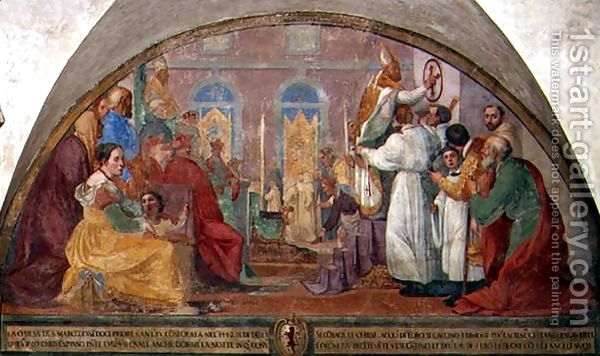
9
Week 9: Monday, December 9, 2024
Every Day Life in Renaissance Florence
Week 9
What was it like to walk the streets, buy food in the market, go to church, live in your townhouse, cook in the kitchen, go to the country, go to school. The best place to see a Renaissance palace as it was in the Renaissance is to visit the Palazzo Davanzati which we will do this week.
REQUIRED READING:

J. H. Plumb,
The Italian Renaissance,
Mariner Books; Revised edition (June 19, 2001),
ISBN 0618127380
RECOMMENDED READING:

John Hale,
The Civilization of Europe in the Renaissance,
Scribner, Reprint edition (June 1, 1995),
ISBN 0684803526

E.R. Chamberlin,
Everyday Life in Renaissance Times (Insights From the Past),
Sapere Books,
ISBN 978-1800555013
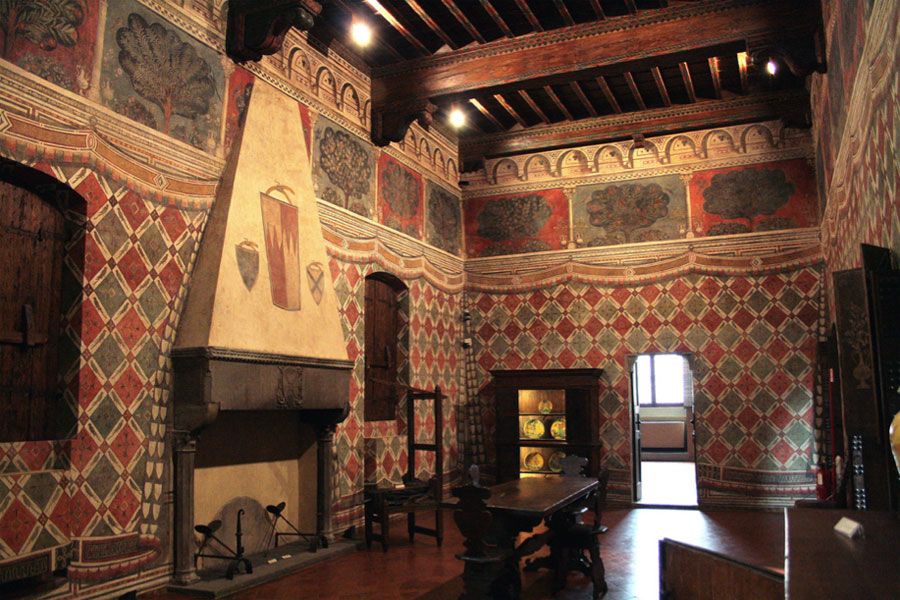
10
Week 10: Monday, December 16, 2024
The Renaissance at Midcentury
Week 10
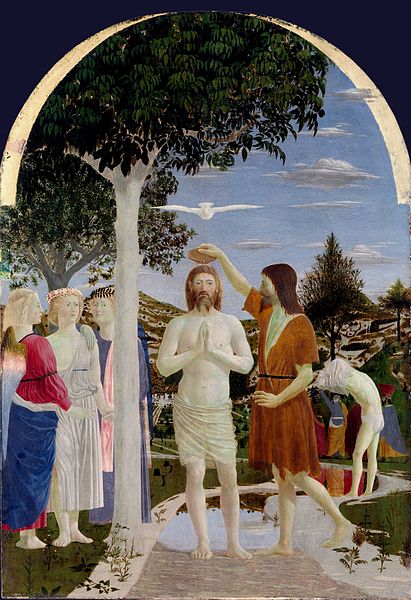
During our tenth week we will assess the progress of the Renaissance at midcentury. And there is no better figure to represent this year of 1450 than the universal genius of Piero della Francsca. Piero was born in the small town of Sansepolcro near Arezzo. But he came to Florence to study art at the height of the early Renaissance. Other artists working in Florence at the same time included Fra Angelico, Domenico Veneziano, and the two grand old men of the Renaissance: Brunelleschi and Donatello. Botticelli and Leonardo were still little babies; Michelangelo and Rafael were not yet born. Piero shows us not only a spectacular painter but also a mathematical genius whose book on mathematics was studied by all later mathematicians including Leonardo da Vinci.
REQUIRED READING:

J. H. Plumb,
The Italian Renaissance,
Mariner Books; Revised edition (June 19, 2001),
ISBN 0618127380
RECOMMENDED READING:
This is the masterpiece by our greatest living expert on Piero della Francesca and only one year old. New photographs and a brilliant text. If you love Piero della Francesca as I do, then you will want to own this beautiful book.

James R. Banker,
Piero della Francesca: Artist and Man,
Oxford University Press; 1 edition (April 15, 2014),
ISBN 0199609314
James R. Banker is professor emeritus of Italian history at North Carolina State University, and lives for most of the year in Florence and Sansepolcro. An expert on the life and works of Piero della Francesca and Sassetta, two artists closely associated with San Sepolcro, his research has emphasized the role of lay religion in the lives of early Renaissance Italians, and the role of patrons, lay and clerical, in the paintings of both Sassetta and Piero. Author of numerous articles on Renaissance themes, his books include Death in the Community: Memorialization and Confraternities in an Italian Commune and, most recently, The Culture of San Sepolcro During the Youth of Piero della Francesca.
From a Reader, via Amazon: The great Piero book now is James Banker’s Piero della Francesca, Artist and Man. It is astonishing in many ways. Banker began simply as a historian studying the medieval commune of San Sepolcro, found Piero in that mix, and busied himself writing two books on the documentation, such as it is, of Piero in the town archives. That started maybe 30 years ago. Now he has written about every aspect of Piero––artist, mathematician, possible architect, citizen, family man––connecting many dots, dispelling old hearsay notions, giving a very fine sense of who this Piero may have been, his boundless curiosity and intellectual connections, and how he did what he did. There are parts I disagree with (especially Banker's interpretation of The Flagellation, which all too easily dismisses the Oriental look of the lefthand foregound figure), and you must be prepared for Banker’s rather hard-nosed refusal to see the kind of spiritual (if not Platonic) light that nonetheless many of us cannot help but see. But it is very good history, plainly written––"just the facts," as it were, with straight declarative sentences abounding–– and eventually had me in tears, both for the understanding of Piero himself and for Banker’s devotion.

John Hale,
The Civilization of Europe in the Renaissance,
Scribner, Reprint edition (June 1, 1995),
ISBN 0684803526

Ferdinand Schevill,
Medieval and Renaissance Florence,
Harper Torchbook paperback, 1963, 2 volumes,
ISBN B000PX4SUU
Christmas Vacation: December 21, 2015 through January 1, 2016
Christmas Vacation. No class.
We are off for December 21, and December 28.
Winter Quarter begins Monday January 4, 2016.
All
Week 1: Mon., Oct. 7, 2024
Manuel Chrysoloras Comes to Florence
Week 1

In 1390, Manuel Chrysoloras (1355-1415) came to Venice on a diplomatic errand as the representative of the Byzantine Emperor in Constantinople. While visiting Venice he met a number of Florentines and one, Giacomo da Scarperia, followed him home to Constantinople to study Greek. Other Florentines heard about Chrysoloras and therefore in 1396, the Florentine Chancellor Coluccio Salutati invited Chrysoloras to come to Florence as a professor of Greek. Chrysoloras would teach the ancient language to whomever might want to attend the classes. This event—a formal program of Europeans studying Greek—is as useful a mark for the beginning of the Renaissance as any. With the arrival of Chrysoloras in Florence, almost a thousand years of Western European ignorance of Greek came to an end. And with this new field of study came new books, new publications, new ideas. The study of Greek sparked new interest in mathematics, astronomy, geography, geometry, optics, and cartography. By the 1420’s Florence found itself the center of an international movement that would create modern Europe.
REQUIRED READING: This week, Chapter IV, "Florence"
Our text for this Fall Quarter is the very fine introduction to the Renaissance by one of our greatest historians, J. R. Plumb. This inexpensive volume will serve us well for all ten weeks of the Fall Quarter. Please read the beautiful obituary that appeared in 2001, when Professor Plumb died, and you will be able to better appreciate his achievements.

J. H. Plumb,
The Italian Renaissance,
Mariner Books; Revised edition (June 19, 2001),
ISBN 0618127380
Amazon: Spanning an age that witnessed great achievements in the arts and sciences, this definitive overview of the Italian Renaissance will both captivate ordinary readers and challenge specialists. Dr. Plumb’s impressive and provocative narrative is accompanied by contributions from leading historians, including Morris Bishop, J. Bronowski, Maria Bellonci, and many more, who have further illuminated the lives of some of the era’s most unforgettable personalities, from Petrarch to Pope Pius II, Michelangelo to Isabella d'Este, Machiavelli to Leonardo. A highly readable and engaging volume, THE ITALIAN RENAISSANCE is a perfect introduction to the movement that shaped the Western world.
RECOMMENDED READING:
J. R. Hale, The Civilization of Europe in the Renaissance. This study of the whole Renaissance period in all of Europe was the final masterpiece of one of the greatest historians of the Early Modern period. John Hale was working on this book when he suffered a debilitating stroke. But his wife, Sheila Hale, and other scholars finished the book for publication and we are all enriched by its availability. It is in print, but you might also look at used copies of the original quality paperback. This book will serve us for the whole year-long course. It is especially useful for Winter and Spring Quarters.

John Hale,
The Civilization of Europe in the Renaissance,
Scribner, Reprint edition (June 1, 1995),
ISBN 0684803526
Ferdinand Schevill, Medieval and Renaissance Florence. The Schevill book that we used in on our class during "The History of Medieval Italy," is still useful for this Renaissance class. But this year you would only want Volume 2 on Renaissance Florence. It is a very detailed historical record of events in Florence during the Fifteenth Century. If you want one book to give you the year by year events and explanations of basic political structures, this is the book you want to own. Copies of both volumes are in our Institute library.
This two-volume history of Florence is the best detailed study of Florence ever written. Schevill wrote a masterpiece of well researched narrative history for Florence in 1936 and then it was republished in a Harper Torchbook paperback in 1961. The Harper Torchbook is still out there in used book stores so we have purchased five for our library. But there are still copies left if you want to own one. It is two volumes with the first volume devoted to our period of Medieval History and the second volume on Renaissance Florence. For the Lombards see Medieval Florence (Volume 1) Chapter Three, "Darkness Over Florence."

Ferdinand Schevill,
Medieval and Renaissance Florence,
Harper Torchbook paperback, 1963, 2 volumes,
ISBN B000PX4SUU
Week 2: Mon., Oct. 14, 2024
Ptolemy Comes to Florence
Week 2

Claudius Ptolemy was a Greek mathematician living in Alexandria from about 90 AD to 168 AD. He was living in the international Roman Empire within which Egypt was now just another province. His Greek language heritage connected him to the whole Greek scientific tradition. He had access to everything back to Thales, including Aristotle, Plato, Euclid— everything. In the great metropolis of Alexandria with the greatest library in the world, Ptolemy brought together in his book, Geography, all knowledge of the globe that Greek science had gathered. He is the first writer to explain completely the idea of latitude and longitude. He provided latitude and longitude locations for all the major cities of Europe. He also provided in his book a how-to guide on drawing maps of the three dimensional globe on two dimensional flat paper. Ptolemy's book was brought to Florence in 1400, probably by Manuel Chrysoloras, and the new arrival of this book in Europe sparked the whole Fifteenth Century research in cartography and led directly to the journey of Christopher Columbus to North America.
REQUIRED READING:

J. H. Plumb,
The Italian Renaissance,
Mariner Books; Revised edition (June 19, 2001),
ISBN 0618127380
RECOMMENDED READING:
1. J. R. Hale, The Civilization of Europe in the Renaissance. This study of the whole Renaissance period in all of Europe was the final masterpiece of one of the greatest historians of the Early Modern period. John Hale was working on this book when he was struck with a debilitating stroke. But his wife, Sheila Hale, and other scholars finished the book for publication and we are all enriched by its availability. It is in print, but you might also look at used copies of the original quality paperback. This book will serve us for the whole year-long course. It is especially useful for Winter and Spring Quarters.

John Hale,
The Civilization of Europe in the Renaissance,
Scribner, Reprint edition (June 1, 1995),
ISBN 0684803526
2. Ferdinand Schevill, Medieval and Renaissance Florence. The Schevill book that we used in on our class during "The History of Medieval Italy," is still useful for this Renaissance class. But this year you would only want Volume 2 on Renaissance Florence. It is a very detailed historical record of events in Florence during the Fifteenth Century. If you want one book to give you the year by year events and explanations of basic political structures, this is the book you want to own. Copies of both volumes are in our Institute library.

Ferdinand Schevill,
Medieval and Renaissance Florence,
Harper Torchbook paperback, 1963, 2 volumes,
ISBN B000PX4SUU
Week 3: Mon., Oct. 21, 2024
Vitruvius Comes to Florence
Marcus Vitruvius Pollio (80 BC to 15 BC) was a Roman architect, engineer and author. His greatest work was his book On Architecture. Below you see a 17th Century engraving of Vitruvius presenting his book on architecture to Emperor Augustus. De architectura is a treatise on architecture written by the Roman architect Vitruvius and dedicated to his patron, the emperor Caesar Augustus, as a guide for building projects. Vitruvius' book is our only surviving work on Roman art. It includes not only architecture but comments on other visual arts as well. Probably written around 15 BC, it is the only contemporary source on classical architecture to have survived, except for the loss of all original illustrations. Divided into ten sections or "books", it covers almost every aspect of Roman architecture. The books break down as:
De architectura – Ten Books on Architecture
- Town planning, architecture or civil engineering in general, and the qualifications required of an architect or more modernly the civil engineer
- Building materials
- Temples and the orders of architecture
- 'continuation of book IV'
- Civil buildings
- Domestic buildings
- Pavements and decorative plasterwork
- Water supplies and aqueducts
- Sciences influencing architecture – geometry, measurement, astronomy, sundial
- Use and construction of machines - Roman siege engines, water mills, drainage machines, Roman technology, hoisting, pneumatics
Vitruvius' book was rediscovered in a Swiss monastery of the Abbey of Saint Gallen by Florentine scholar Poggio Bracciolini, and a copy of the book was brought to Florence in 1414. Brunelleschi used Vitruvius to develop his new idea of linear perspective.
REQUIRED READING:

J. H. Plumb,
The Italian Renaissance,
Mariner Books; Revised edition (June 19, 2001),
ISBN 0618127380
RECOMMENDED READING:

John Hale,
The Civilization of Europe in the Renaissance,
Scribner, Reprint edition (June 1, 1995),
ISBN 0684803526
RECOMMENDED READING:
This is a wonderful book that is perfect for us as we spend a week talking about Brunelleschi and Renaissance Florence. I highly recommend it to you all. And now it is available in paperback.

Week 4: Mon., Oct. 28, 2024
Why Florence?
Week 4
Why did Florence turn out to be so special in 1400? For the answer we must go back into the medieval history of Florence and trace the growth of democratic institutions in the growing republic. The republic of Florence grew out of the debris of the dying Roman Empire. As the empire collapsed, local citizens had to organize in an attempt to provide services and establish some local order. All over Italy, in the 500 years from the last of imperial control in Italy (c. 564) to the birth of new Italy in 1000 AD, local officials reacted to the chaos of the imperial collapse. In each small state, experiments were begun in order to create local civic structures. By the late 1200's (during the lifetime of Dante) Florence had created a vibrant genuinely democratic regime dominated by the commercial middle class. This democracy learned how to support industry, export-import, labor, and a banking system. Even the catastrophe of the Black Death in 1348 could not stop the success of the Florentine Republic. By 1400, Florence was more successful than ever.
REQUIRED READING:

J. H. Plumb,
The Italian Renaissance,
Mariner Books; Revised edition (June 19, 2001),
ISBN 0618127380
Amazon: Spanning an age that witnessed great achievements in the arts and sciences, this definitive overview of the Italian Renaissance will both captivate ordinary readers and challenge specialists. Dr. Plumb’s impressive and provocative narrative is accompanied by contributions from leading historians, including Morris Bishop, J. Bronowski, Maria Bellonci, and many more, who have further illuminated the lives of some of the era’s most unforgettable personalities, from Petrarch to Pope Pius II, Michelangelo to Isabella d'Este, Machiavelli to Leonardo. A highly readable and engaging volume, THE ITALIAN RENAISSANCE is a perfect introduction to the movement that shaped the Western world.
RECOMMENDED READING:
J. R. Hale, The Civilization of Europe in the Renaissance. This study of the whole Renaissance period in all of Europe was the final masterpiece of one of the greatest historians of the Early Modern period. John Hale was working on this book when he suffered a debilitating stroke. But his wife, Sheila Hale, and other scholars finished the book for publication and we are all enriched by its availability. It is in print, but you might also look at used copies of the original quality paperback. This book will serve us for the whole year-long course. It is especially useful for Winter and Spring Quarters.

John Hale,
The Civilization of Europe in the Renaissance,
Scribner, Reprint edition (June 1, 1995),
ISBN 0684803526
Week 5: Mon., Nov. 4, 2024
Money, Banks and the Florin
Week 5
How did Florence get so rich by 1400? During week 5 we want to explore the generation of wealth. How does it happen? What are the factors that promote the wealth of a people? And what did Florence do between 1200 and 1400 that turned out to be the right things. What were some of these creations: 1) a sound money; 2) a banking system; 3) government support for property rights.
REQUIRED READING:

J. H. Plumb,
The Italian Renaissance,
Mariner Books; Revised edition (June 19, 2001),
ISBN 0618127380
RECOMMENDED READING:
The Raymond de Roover study of the Medici bank is a masterpiece of economic history.

Raymond de Roover,
The Rise and Decline of the Medici Bank: 1397-1494,
Beard Books (August 19, 1999),
ISBN 1893122328
Review
The book combines superb research and analysis with graceful writing...(work) from archival material, make (this) valuable... -- Turnarounds and Workouts, October 15, 1999 Review by Susan Pannell
From the Publisher
A classic history of banking and trade in the medieval period, combining superb research and analysis with graceful writing. The Medici Bank was the most powerful banking house of the 15th century. Headquartered in Florence, Italy, it established branches in Rome, Venice, Geneva, Lyons, Bruges, London, and many other cities. The bank served as financial agent of the Church, extended credit to monarchs, and facilitated international trade in Western Europe. By their personal influence and the use of their profits, the owners and administrators of the bank contributed significantly to the development of Florence as the greatest center of the Renaissance.

John Hale,
The Civilization of Europe in the Renaissance,
Scribner, Reprint edition (June 1, 1995),
ISBN 0684803526

Week 6: Mon., Nov. 11, 2024
The Catasto in Florence
Week 6
Who was rich and who was not in Renaissance Florence. The Catasto tells us. The Catasto was a innovation in taxation. In 1427, facing huge military costs as the little republic fought the big ric h state of Milan, the leaders of Florence decided that everyone should contribute to the cost of running the Republic. And I an attempt to make taxation more fair, they passed a law that established the Catasto. In the imposition of the new tax system, all Florentine citizens were asked to file a written assessment of all their wealth
With the Republic's Tax office. Then with this document on file, the Republic now asked all citizens to pay 1% (the amount varied over the different years of the existence of the Catasto) tax on their total wealth. Of course tax investigators could go door to door and check on the self-assessment. But the most important thing for us in the 21st century is that all these documents still exist in the Archivio di Stato Firenze. And scholars have been able to summarize the overall wealth, wealth distribution and everything else about money in Florence in 1327. In this our week 7 we will report some of their findings.
RECOMMENDED READING:
This is one of the greatest achievements of recent historical scholarship. Herlihy and Klapisch-Zuber studied the whole of the Catasto and with the results they were able to describe in fascinating detail the daily life in Florence in the early years of the fifteenth century.
The kindle edition is a reasonable price. And there are both new and used copies of the paperback.

Christiane Klapisch-Zuber and David Herlihy,
Tuscans and Their Families: A Study of the Florentine Catasto of 1427,
ACLS Humanities E-Book (August 1, 2008),
ISBN 1597405159

John Hale,
The Civilization of Europe in the Renaissance,
Scribner, Reprint edition (June 1, 1995),
ISBN 0684803526

Week 7: Mon., Nov. 18, 2024
The Families of Florence
Week 7
Italian society has always been dominated by families. Renaissance Florence was no exception. There were about 100 great families that led the Florentine Republic in the 300 years between 1200 and 1500. But for the great period of the Renaissance Florence (1400-1500) three families had extraordinary power: the Medici, the Strozzi, and the Rucellai.
Our reading for this week is one of the most valuable documents to come down to us from Renaissance Florence. This collection of letters written by Alessandra degli Strozzi to her children living outside of Florence, provides us with an insight into what life was like for the upper class Strozzi family in a world dominated by the Medici. Get your own copy so that you can appreciate her wit and charm.
REQUIRED READING:

Heather Gregory,
The Selected Letters of Alessandra degli Strozzi,
University of California Press, Bilingual ed edition (February 1, 1997),
ISBN 0520203909
The Institute's Outline of Letters
RECOMMENDED READING:
J. R. Hale, The Civilization of Europe in the Renaissance. This study of the whole Renaissance period in all of Europe was the final masterpiece of one of the greatest historians of the Early Modern period. John Hale was working on this book when he suffered a debilitating stroke. But his wife, Sheila Hale, and other scholars finished the book for publication and we are all enriched by its availability. It is in print, but you might also look at used copies of the original quality paperback. This book will serve us for the whole year-long course. It is especially useful for Winter and Spring Quarters.

John Hale,
The Civilization of Europe in the Renaissance,
Scribner, Reprint edition (June 1, 1995),
ISBN 0684803526

NO CLASS NEXT WEEK THANKSGIVING VACATION ALL WEEK
Week 8: Mon., Dec. 2, 2024
Florence and the Popes
Week 8
The wealth of Florence meant that Florentines would be immensely influential as the Papacy began to rebuild the institution after the disasters of the Fourteenth Century. The Avignon Papacy had alienated England. The Schism with three popes had alienated almost everybody and then finally the Council of Constance in 1415 had tried to find a candidate to rebuild the church. They chose a Roman, Martin of the great Colonna family. But Martin spent many years living in Florence and Pope Eugenius IV (seen below consecrating the Florentine monastery of San Marco) lived in Florence in the cloister of Santa Maria Novella for a decade. Both popes solicited funds from the Medici and others in their efforts to rebuild both the city and the church of Rome.
REQUIRED READING:

J. H. Plumb,
The Italian Renaissance,
Mariner Books; Revised edition (June 19, 2001),
ISBN 0618127380
RECOMMENDED READING:

John Hale,
The Civilization of Europe in the Renaissance,
Scribner, Reprint edition (June 1, 1995),
ISBN 0684803526

Week 9: Mon., Dec. 9, 2024
Every Day Life in Renaissance Florence
Week 9
What was it like to walk the streets, buy food in the market, go to church, live in your townhouse, cook in the kitchen, go to the country, go to school. The best place to see a Renaissance palace as it was in the Renaissance is to visit the Palazzo Davanzati which we will do this week.
REQUIRED READING:

J. H. Plumb,
The Italian Renaissance,
Mariner Books; Revised edition (June 19, 2001),
ISBN 0618127380
RECOMMENDED READING:

John Hale,
The Civilization of Europe in the Renaissance,
Scribner, Reprint edition (June 1, 1995),
ISBN 0684803526

E.R. Chamberlin,
Everyday Life in Renaissance Times (Insights From the Past),
Sapere Books,
ISBN 978-1800555013

Week 10: Mon., Dec. 16, 2024
The Renaissance at Midcentury
Week 10

During our tenth week we will assess the progress of the Renaissance at midcentury. And there is no better figure to represent this year of 1450 than the universal genius of Piero della Francsca. Piero was born in the small town of Sansepolcro near Arezzo. But he came to Florence to study art at the height of the early Renaissance. Other artists working in Florence at the same time included Fra Angelico, Domenico Veneziano, and the two grand old men of the Renaissance: Brunelleschi and Donatello. Botticelli and Leonardo were still little babies; Michelangelo and Rafael were not yet born. Piero shows us not only a spectacular painter but also a mathematical genius whose book on mathematics was studied by all later mathematicians including Leonardo da Vinci.
REQUIRED READING:

J. H. Plumb,
The Italian Renaissance,
Mariner Books; Revised edition (June 19, 2001),
ISBN 0618127380
RECOMMENDED READING:
This is the masterpiece by our greatest living expert on Piero della Francesca and only one year old. New photographs and a brilliant text. If you love Piero della Francesca as I do, then you will want to own this beautiful book.

James R. Banker,
Piero della Francesca: Artist and Man,
Oxford University Press; 1 edition (April 15, 2014),
ISBN 0199609314
James R. Banker is professor emeritus of Italian history at North Carolina State University, and lives for most of the year in Florence and Sansepolcro. An expert on the life and works of Piero della Francesca and Sassetta, two artists closely associated with San Sepolcro, his research has emphasized the role of lay religion in the lives of early Renaissance Italians, and the role of patrons, lay and clerical, in the paintings of both Sassetta and Piero. Author of numerous articles on Renaissance themes, his books include Death in the Community: Memorialization and Confraternities in an Italian Commune and, most recently, The Culture of San Sepolcro During the Youth of Piero della Francesca.
From a Reader, via Amazon: The great Piero book now is James Banker’s Piero della Francesca, Artist and Man. It is astonishing in many ways. Banker began simply as a historian studying the medieval commune of San Sepolcro, found Piero in that mix, and busied himself writing two books on the documentation, such as it is, of Piero in the town archives. That started maybe 30 years ago. Now he has written about every aspect of Piero––artist, mathematician, possible architect, citizen, family man––connecting many dots, dispelling old hearsay notions, giving a very fine sense of who this Piero may have been, his boundless curiosity and intellectual connections, and how he did what he did. There are parts I disagree with (especially Banker's interpretation of The Flagellation, which all too easily dismisses the Oriental look of the lefthand foregound figure), and you must be prepared for Banker’s rather hard-nosed refusal to see the kind of spiritual (if not Platonic) light that nonetheless many of us cannot help but see. But it is very good history, plainly written––"just the facts," as it were, with straight declarative sentences abounding–– and eventually had me in tears, both for the understanding of Piero himself and for Banker’s devotion.

John Hale,
The Civilization of Europe in the Renaissance,
Scribner, Reprint edition (June 1, 1995),
ISBN 0684803526

Ferdinand Schevill,
Medieval and Renaissance Florence,
Harper Torchbook paperback, 1963, 2 volumes,
ISBN B000PX4SUU
Christmas Vacation: December 21, 2015 through January 1, 2016
Christmas Vacation. No class.
We are off for December 21, and December 28.
Winter Quarter begins Monday January 4, 2016.

